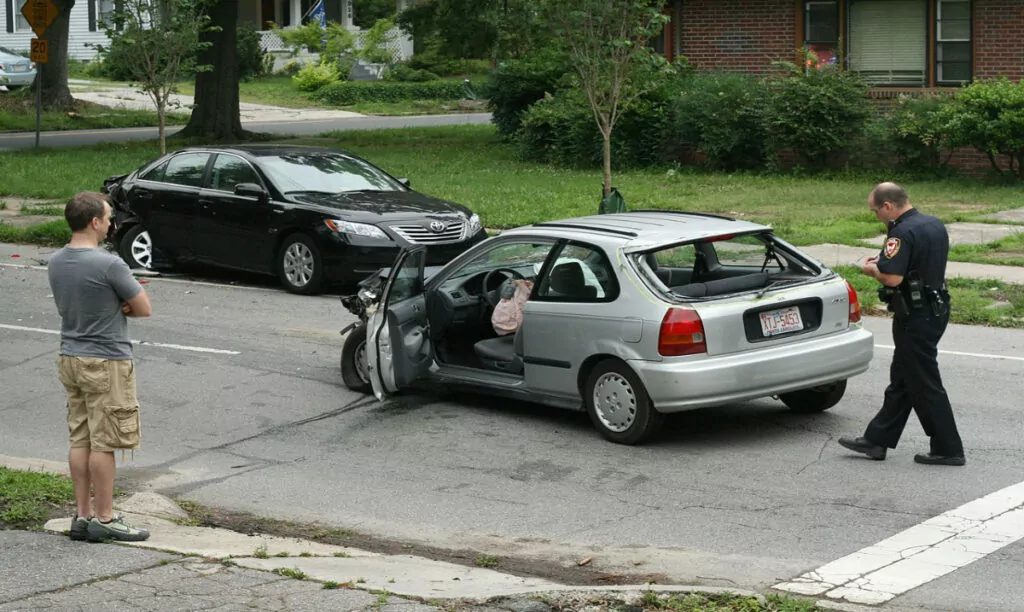
There are several strategies on how to prevent an automobile accident, including not driving impaired or distracted, keeping your car in good condition and practicing defensive driving. (Wikimedia photo by IldarSagdejev)
It’s important to know what to do after an accident (see this blog), but here are some things you should know about how to prevent an automobile accident in the first place.
Be Certain you’re in Good Enough Condition to Drive— not too tired, not intoxicated, not angry or upset. Also, make sure you see your eye doctor regularly to check for any needed vision corrections. And see your regular physician too make certain you are healthy enough to drive so you don’t experience a medical crisis behind the wheel.
We mentioned intoxication, but we want to emphasize how important it is not to drink or take drugs before or while driving. If you have “just a coupleof drinks,” your blood alcohol content can get to 0.05 percent—0.03 percent less the legal limit in California. But even at 0.05 percent, your chances of getting in an accident double, according to this Washington Post article, citing NHTSA studies.
Some insurance companies sometimes even try to refuse to pay claims if a driver has any alcohol in his blood—even if it’s under the legal limit.
A 682% Increase of Risk
A 160-pound man having five drinks in an hour has a BAC reading of about 0.12 percent and an increased crash risk of 682 percent!
And while driving high on marijuana results in much less risk of getting in a crash than drinking and driving, according to the National Highway Traffic Safety Administration, you would face the exact same legal consequences in California if you’re caught stoned and driving.
An NHTSA Study Reports on a Large European Study of Impaired Driving and Marijuana:
Odds ratios were used to estimate the risk of crash involvement after marijuana use in the fatally and seriously injured drivers. The results for the seriously injured drivers showed considerable national variability, ranging from 0.29 times (reduced crash involvement) to 25.38 times (increased crash involvement). The combined risk was 1.39 times that of drug-free drivers, but this was not statistically significant. For fatally injured drivers the estimated risk ranged from 3.91 to 28.88, while the combined risk was 1.33 times (also not statistically significant).
Don’t Text and Drive
Avoid distractions during driving—including texting or talking on the cell phone. The stakes are high. The government website Distraction.gov reports there were 3,179 people killed and about 431,000 injured in distracted-driving accidents in 2014.
Distracted driving includes eating, changing clothes, talking to passengers, grooming, using a navigation system or adjusting the audio player or anything else that takes your attention off of driving.
The worst distraction is texting and driving, which increases the chance of an accident 2,300 percent—23 times as much!
And California has laws against texting and cell phone use (see this blog: Texting and hand-held phone use are outlawed because they’re so perilous).
Check your Car’s Condition
Make certain your car, van, motorcycle or truck is in good driving condition. Regularly check or have a mechanic check your brakes, fluid levels, air pressure in the tires, and follow all the maintenance instructions in your owner’s manual.
How to Prevent an Automobile Accident
Drive defensively. Kidshealth.org offers tips on defensive driving, including:
- Be cautious, alert and do not be aggressive. Put safety first.
- Pay attention to your driving at all times.
- Wear your seatbelt. Seatbelts greatly increase your chance of surviving an accident and also reduce risk of injury.
- Leave a big distance—about 3 to 4 seconds’ traveling time—between your vehicle and the car ahead of you.
- Frequently check mirrors, scan around you and 20 to 30 seconds ahead of you so you are ready to react to any dangerous situations.
- If you see someone driving aggressively, slow down or pull over until he’s past you.
- Go the speed limit, or under it if the roads are icy or wet.
- Constantly check for an escape route, where you can maneuver if danger arises.
- Be aware of intersections. Don’t assume other drivers will be considerate and move out of your way. Assume that they’ll run stop signs and red lights, for example. Be prepared to react when your vehicle is in the vicinity of other vehicles and at intersections.
- Don’t worry about your pride—yield if someone may be about to cut you off.
- Don’t run red or yellow lights.
- Use your signaling devices—and make certain they and your brake lights are in working order.
- Pass safely. Make certain you have plenty of time to get around a vehicle on a two-lane highway. When in doubt, don’t pass.
(We took some of these tips from RoadTripAmerica.com, which has an article 70 Rules of Defensive Driving.)
If you do Get in a Accident, call Krasney Law Right Away!!
If despite all your precautions you do get in an accident, Krasney Law of Los Angeles and San Bernardino would appreciate an opportunity to talk to you, especially if you sustained serious injuries. The initial consultation is free, and we collect no fees unless there is a monetary recovery or your case goes to trial. The fact is that even if we collect a contingency fee, you are likely to receive more compensation than if you deal with the insurance companies on your own.
Our phone number is (909) 380-7200. Or you may contact us on the Web at https://krasneylaw.net/contact-us/. We can discuss your insurance situation, the laws surrounding your case and how to proceed with doctors and medical care if you were injured. Please call us today. And don’t forget!! NO RECOVERY – NO FEE!!!

